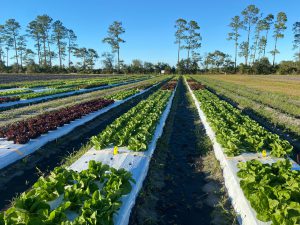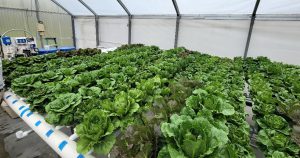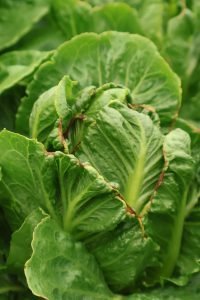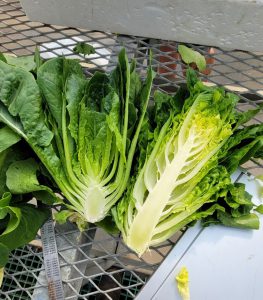BY JESSE MURRAY

Each year, U.S. farmers produce enough lettuce to feed everyone in the country.
Up to 73% of U.S. lettuce comes from California producers and is distributed nationwide through extensive retail chains. Lettuce grown in Florida accounts for 3% of the national total, and has a unique market window during the winter months. Traditionally, Florida lettuce has been grown between October and April in the rich muck soils of the Everglades Agricultural Area (EAA), just south of Lake Okeechobee. Recent advances in technology and changes in consumer preferences have seen the Florida lettuce industry expand into emerging production systems, with at least 240 operations occurring in controlled environments such as greenhouse hydroponic systems.
Researchers with the University of Florida Lettuce Breeding Program at the Institute of Food and Agricultural Sciences are working to help growers deliver high-quality lettuce when growing in these systems. Professor Germán Sandoya and Ph.D. candidate Jesse Murray lead the research.
“Consumers in growing urban areas such as Miami, Tampa, Orlando and Jacksonville may increasingly become attracted to vegetables produced near their ‘backyard’, which might be purchased in fresher conditions that maintain the appearance and nutritional value”, explains Murray.
“Our goal is to provide traditional and new types of lettuce varieties better adapted to the unique conditions across the state of Florida,” said Sandoya.

Some important issues they’re working on improving are tolerance to hotter temperatures, and maintaining postharvest storage quality and nutritional content.
“During the last few decades, the Florida lettuce season has been constricted by about a month due to increased temperatures at the beginning and end of the winter growing season,” explained Sandoya. “Lettuce is a cool-season crop and may develop physical defects when grown in heat such as tipburn and bolting, making the crop unmarketable. It is also important to understand which lettuce varieties can store better after harvest, and what practices should be implemented to help reduce food waste in these newer growing systems.”
Investigating nutritional quality is of particular interest to Murray.
“My research is focused on understanding the vitamin and nutritional content of lettuce grown in Florida.” Lettuce types such as romaine, butterhead, leaf, and baby leaf can be a valuable source of vitamins A, C, K, and folate, as well as minerals and

antioxidant compounds,” he said. “I’m interested in seeing which lettuce varieties are capable of maintaining high nutritional content for consumers when grown in these
newer systems and how plants themselves utilize some of these same nutritional compounds to help adapt to stressful conditions

like hot temperatures and postharvest storage.”
A selection of lettuce varieties and breeding materials are being evaluated for characteristics desired by the lettuce industry in hydroponic greenhouse and sandy soils, such as good yield and absence of heat-related defects when grown under ideal winter and warmer temperatures of early fall and late spring. Results from this study may help the lettuce industry identify best management practices, and inform lettuce breeders how to develop improved cultivars, for growing lettuce in different systems in Florida.
Anyone interested in learning more about Florida lettuce production can visit the UF-IFAS Extension Publication website or research the UF Lettuce Breeding Program.
Reach Jesse Murray
Twitter: @UfLettuce, @JMBiofort
 1
1
